Lesson Contents
LDP is a protocol that automatically generates and exchanges labels between routers. Each router will locally generate labels for its prefixes and will then advertise the label values to its neighbors.
It’s a standard, based on Cisco’s proprietary TDP (Tag Distribution Protocol). It’s pretty much the same story as 802.1Q/ISL or PaGP/LACP. Cisco created a protocol, and a standard was created later. Nowadays, almost everyone uses LDP instead of TDP.
Key Takeaways
- LDP uses UDP multicast group address 224.0.0.2 for neighbor discovery and TCP for the actual label exchange session.
- Routers form a single LDP neighbor adjacency using loopback addresses (transport addresses).
- The Label Information Base (LIB) stores all learned label mappings from neighbors.
- The Label Forwarding Information Base (LFIB) is used for actual MPLS packet forwarding decisions
- Penultimate hop popping (PHP) removes the MPLS label at the second-to-last router to optimize forwarding
Prerequisites
Before working with LDP, you should understand:
- The basics of MPLS and what label switching is.
- The basics of Cisco Express Forwarding (CEF) are important because there is a relation between the RIB and FIB.
Explanation
Like many other protocols, LDP first establishes a neighbor adjacency before it exchanges label information. It works a bit differently than most protocols, though.
First, we send UDP multicast hello packets to discover other neighbors. Once two routers decide to become neighbors, they build the neighbor adjacency using a TCP connection. This connection is then used for the exchange of label information. Normally, a loopback interface is used for the neighbor adjacency. Here’s an example:
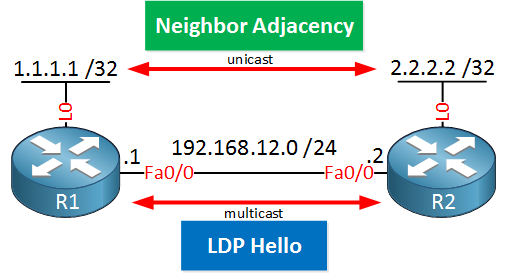
The two routers above will send multicast hello packets on their FastEthernet interfaces. Within this hello packet, they will advertise a transport IP address. This IP address is then used to establish the TCP connection between the two routers.
Here’s what the hello packet looks like in wireshark:
Frame 4: 76 bytes on wire (608 bits), 76 bytes captured (608 bits) on interface 0
Ethernet II, Src: Cisco_8b:36:d0 (00:1d:a1:8b:36:d0), Dst: IPv4mcast_02 (01:00:5e:00:00:02)
Internet Protocol Version 4, Src: 192.168.12.1 (192.168.12.1), Dst: 224.0.0.2 (224.0.0.2)
User Datagram Protocol, Src Port: 646 (646), Dst Port: 646 (646)
Label Distribution Protocol
Version: 1
PDU Length: 30
LSR ID: 1.1.1.1 (1.1.1.1)
Label Space ID: 0
Hello Message
0... .... = U bit: Unknown bit not set
Message Type: Hello Message (0x100)
Message Length: 20
Message ID: 0x00000000
Common Hello Parameters TLV
00.. .... = TLV Unknown bits: Known TLV, do not Forward (0x00)
TLV Type: Common Hello Parameters TLV (0x400)
TLV Length: 4
Hold Time: 15
0... .... .... .... .... = Targeted Hello: Link Hello
.0.. .... .... .... .... = Hello Requested: Source does not request periodic hellos
..0. .... .... .... .... = GTSM Flag: Not set
...0 0000 0000 0000 = Reserved: 0x0000
IPv4 Transport Address TLV
00.. .... = TLV Unknown bits: Known TLV, do not Forward (0x00)
TLV Type: IPv4 Transport Address TLV (0x401)
TLV Length: 4
IPv4 Transport Address: 1.1.1.1 (1.1.1.1)In the capture above you can see a couple of interesting things:
- The hello packets are sent to multicast address 224.0.0.2 using source/destination UDP port 646.
- Each router has a unique ID called the LSR (Label Switch Router) ID. This is similar to how most protocols select an ID, by default it will select the highest IP address on a loopback interface. If you don’t have any loopback interfaces then we will use the highest IP address on a physical interface.
- At the bottom you find the transport address. This is what we use to build the actual TCP connection. Like the LSR ID, the router selected the IP address on the loopback interface as the transport address.
This is different compared to how routing protocols like OSPF or EIGRP form neighbor adjacencies. For example, when you run OSPF then your routers will form neighbor adjacencies on all interfaces that run OSPF:
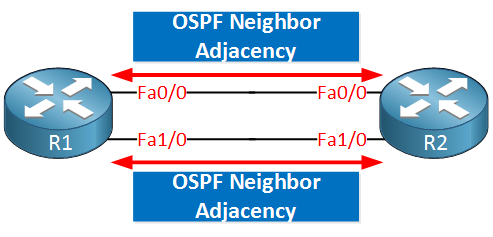
LDP will only form a single neighbor adjacency, no matter how many interfaces you have in between your routers:
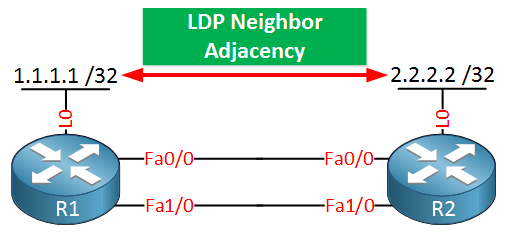
LDP is a bit similar to BGP when you use the loopback interfaces for the neighbor adjacency. When we use BGP we have to use the update-source command to select the source, LDP does it automatically.
So once our LDP routers have become neighbors, how do we exchange label information? To explain this, let’s do a quick review of how normal routing uses the RIB and FIB. If you have no idea what these two are then I recommend you to read my CEF lesson first before you continue.
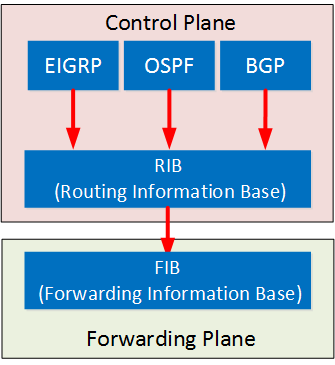
With normal routing, we use routing protocols like EIGRP, OSPF or BGP to learn prefixes from other routers. These are all stored in the RIB (Routing Information Base), this is your routing table.
The information in the RIB is used to build the FIB (Forwarding Information Base) which is what we use for actual forwarding of IP packet. These tables are all used for IP packets but for MPLS we use something else:
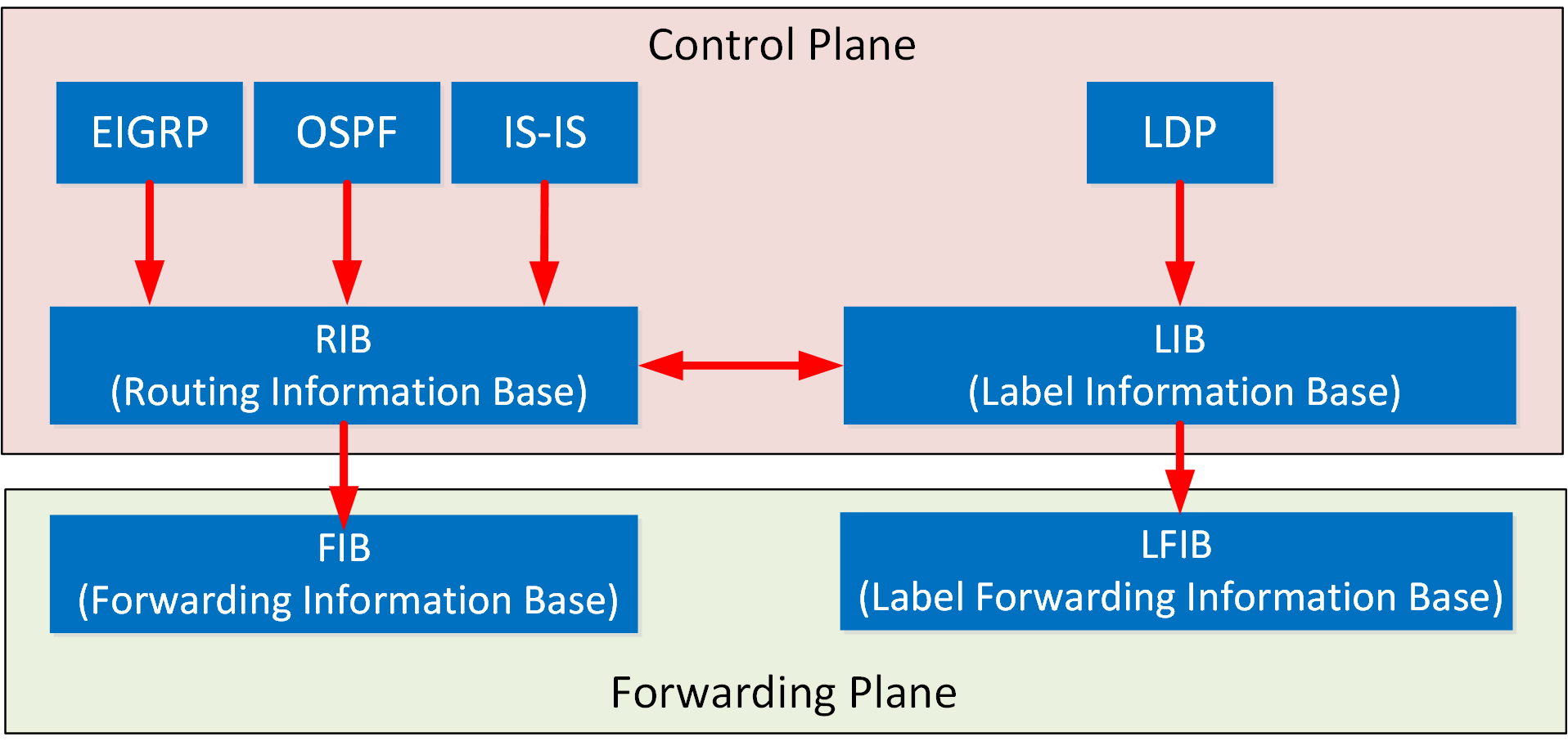
When we use LDP on Cisco IOS, we locally generate a label for each prefix that we can find in the RIB, except for BGP prefixes. This information is then added to the LIB (Label Information Base).
The information in the LIB is used to build the LFIB (Label Forwarding Information Base). When the router has to forward a packet with a MPLS label on it, it will use the LFIB for forwarding decisions.
The LIB is similar to the RIB but it’s used to store labels for prefixes. The LFIB is similar to the FIB, it’s used for actual forwarding of MPLS packets.
Two routers that have formed a LDP neighbor adjacency will exchange the label information in their LIBs to tell each other what label values to use for different prefixes.
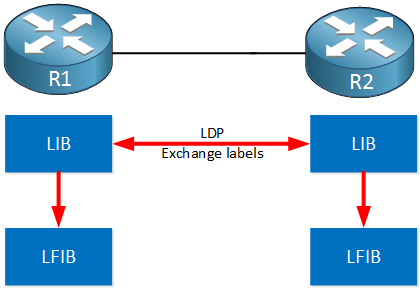
All routers running LDP will now know what label values to use when they switch a MPLS packet to their neighbor.
Now you have an idea what LDP is about, let’s take a look at it in action. I will also show you the different tables that I just described.
Configuration
I will use the following three routers to demonstrate LDP:

Each router has a loopback interface that we will use for the LDP neighbor adjacency. LDP will select the IP addresses on the loopback interfaces as the LSR IDs and the transport addresses. We also need the information in the RIB to build the LIB so I’ll configure OSPF to advertise all prefixes.
OSPF Configuration
Let’s advertise all interfaces:
R1(config)#router ospf 1
R1(config-router)#network 192.168.12.0 0.0.0.255 area 0
R1(config-router)#network 1.1.1.1 0.0.0.0 area 0R2(config)#router ospf 1
R2(config-router)#network 192.168.12.0 0.0.0.255 area 0
R2(config-router)#network 192.168.23.0 0.0.0.255 area 0
R2(config-router)#network 2.2.2.2 0.0.0.0 area 0R3(config)#router ospf 1
R3(config-router)#network 192.168.23.0 0.0.0.255 area 0
R3(config-router)#network 3.3.3.3 0.0.0.0 area 0That’s all we need.
LDP Configuration
There are two ways to configure LDP:
- On the interface level with the mpls ip command.
- Globally under the OSPF process with the mpls ldp autoconfig command.
It doesn’t matter much which one you pick, by default LDP will create a label for each prefix. I’ll enable it on the interfaces this time:
R1(config)#interface FastEthernet 0/0
R1(config-if)#mpls ipR2(config)#interface FastEthernet 0/0
R2(config-if)#mpls ipR2(config)#interface FastEthernet 0/1
R2(config-if)#mpls ipR3(config)#interface FastEthernet 0/0
R3(config-if)#mpls ipAfter a few seconds you will see a message on the consoles telling you that the neighbor is up:
R1#
%LDP-5-NBRCHG: LDP Neighbor 2.2.2.2:0 (1) is UPThat’s all you have to do to enable LDP. Let’s verify our work!
Verification
The messages on the console(s) revealed to us that we have a neighbor adjacency but it still might be useful to check some things yourself.
LDP Neighbor Adjacency
First let’s check if LDP is enabled on the interface:
R1#show mpls interfaces
Interface IP Tunnel BGP Static Operational
FastEthernet0/0 Yes (ldp) No No No YesR2#show mpls interfaces
Interface IP Tunnel BGP Static Operational
FastEthernet0/0 Yes (ldp) No No No Yes
FastEthernet0/1 Yes (ldp) No No No YesR3#show mpls interfaces
Interface IP Tunnel BGP Static Operational
FastEthernet0/0 Yes (ldp) No No No YesThe show mpls interfaces command is a quick way to see if LDP is enabled or not. It tells us what interfaces are enabled and if they are operational or not. The next thing to check is if we have LDP neighbors or not:
R2#show mpls ldp neighbor
Peer LDP Ident: 1.1.1.1:0; Local LDP Ident 2.2.2.2:0
TCP connection: 1.1.1.1.646 - 2.2.2.2.36200
State: Oper; Msgs sent/rcvd: 8/7; Downstream
Up time: 00:00:32
LDP discovery sources:
FastEthernet0/0, Src IP addr: 192.168.12.1
Addresses bound to peer LDP Ident:
192.168.12.1 1.1.1.1
Peer LDP Ident: 3.3.3.3:0; Local LDP Ident 2.2.2.2:0
TCP connection: 3.3.3.3.13500 - 2.2.2.2.646
State: Oper; Msgs sent/rcvd: 8/8; Downstream
Up time: 00:00:12
LDP discovery sources:
FastEthernet0/1, Src IP addr: 192.168.23.3
Addresses bound to peer LDP Ident:
192.168.23.3 3.3.3.3Above, you see the output of R2. Here’s what you see:
- R2 and R3 have become neighbors:
- R2 uses 2.2.2.2 as its LSR ID, R3 uses 3.3.3.3 as the LSR ID.
- R2 and R3 have formed a TCP connection using 2.2.2.2 and 3.3.3.3 as the transport addresses.
- Discovery (hello packets) was done using the FastEthernet0/1 interface.
- R1 and R2 have become neighbors:
- R2 uses 2.2.2.2 as its LSR ID, R1 uses 1.1.1.1 as the LSR ID.
- R1 and R2 have formed a TCP connection using 2.2.2.2 and 1.1.1.1 as the transport addresses.
- Discovery (hello packets) was done using the FastEthernet0/0 interface.
Now we have confirmed that we have LDP neighbors, let’s look at the labels.
LDP Control Plane
When you use LDP, all routers will start assigning labels with label value 16. This might be a bit annoying if you are new to MPLS as some routers will use the same label value. To make it easier to read the different tables I will configure each router to use different label values. Here’s how to do this:
R1(config)#mpls label range 100 199R2(config)#mpls label range 200 299R3(config)#mpls label range 300 399When you use this command you will have to reload the routers, clearing the neighbor adjacency is not enough. Let’s take a look at some labels. Since the LIB is built with information from the RIB, we will start with the routing table. Here’s R1:
R1#show ip route
1.0.0.0/32 is subnetted, 1 subnets
C 1.1.1.1 is directly connected, Loopback0
2.0.0.0/32 is subnetted, 1 subnets
O 2.2.2.2 [110/2] via 192.168.12.2, 00:36:02, FastEthernet0/0
3.0.0.0/32 is subnetted, 1 subnets
O 3.3.3.3 [110/3] via 192.168.12.2, 00:36:02, FastEthernet0/0
192.168.12.0/24 is variably subnetted, 2 subnets, 2 masks
C 192.168.12.0/24 is directly connected, FastEthernet0/0
L 192.168.12.1/32 is directly connected, FastEthernet0/0
O 192.168.23.0/24 [110/2] via 192.168.12.2, 00:36:02, FastEthernet0/0Above you can see the prefixes in the routing table. Here’s what the LIB looks like:
R1#show mpls ldp bindings
lib entry: 1.1.1.1/32, rev 4
local binding: label: imp-null
remote binding: lsr: 2.2.2.2:0, label: 200
lib entry: 2.2.2.2/32, rev 6
local binding: label: 100
remote binding: lsr: 2.2.2.2:0, label: imp-null
lib entry: 3.3.3.3/32, rev 10
local binding: label: 102
remote binding: lsr: 2.2.2.2:0, label: 201
lib entry: 192.168.12.0/24, rev 2
local binding: label: imp-null
remote binding: lsr: 2.2.2.2:0, label: imp-null
lib entry: 192.168.23.0/24, rev 8
local binding: label: 101
remote binding: lsr: 2.2.2.2:0, label: imp-nullAbove you can see the LIB of R1. Let’s walk through some of the things we see here:
- The first entry is for 1.1.1.1/32, the loopback interface of R1. This router doesn’t generate a label value for this entry since it’s directly connected. You can see however that R2 has advertised to R1 that it uses label value 200 for this prefix.
- The second entry is for 2.2.2.2/32. R1 has chosen label value 100 for this entry, we can also see that R2 doesn’t use a label for this prefix. This makes sense since it’s directly connected for R2.
- The third entry for 3.3.3.3/32 has a local label value of 102. R2 is using label value 201 for this entry.
- The fourth entry is 192.168.12.0/24. We don’t use a label for this entry since it’s directly connected. R2 also doesn’t use a label value since it’s directly connected there as well.
- The fifth entry is for 192.168.23.0/24, R1 uses label value 101 for this one.
Now let’s take a look at the LFIB, that’s what we will actually use when we forward MPLS packets:
R1#show mpls forwarding-table
Local Outgoing Prefix Bytes Label Outgoing Next Hop
Label Label or Tunnel Id Switched interface
100 Pop Label 2.2.2.2/32 0 Fa0/0 192.168.12.2
101 Pop Label 192.168.23.0/24 0 Fa0/0 192.168.12.2
102 201 3.3.3.3/32 0 Fa0/0 192.168.12.2The LFIB is much smaller, keep in mind that this is similar to the CEF table that we use for IP forwarding. There is no entry for 1.1.1.1 /32 or 192.168.12.0 /24 here since we don’t have a label for these prefixes. When we want to reach 3.3.3.3 /32 then we will add label value 201 to the MPLS header before we send it to R2.
When R1 receives something for 2.2.2.2/32 or 192.168.23.0/24 then we will “pop the label” before we forward it to R2. This is called penultimate hop popping. I’ll explain this in more detail in another post, it’s done to save R2 some time by already removing the MPLS header.
Let me also show you the RIB, LIB and LFIB of R2 and R3:
R2#show ip route
1.0.0.0/32 is subnetted, 1 subnets
O 1.1.1.1 [110/2] via 192.168.12.1, 00:44:37, FastEthernet0/0
2.0.0.0/32 is subnetted, 1 subnets
C 2.2.2.2 is directly connected, Loopback0
3.0.0.0/32 is subnetted, 1 subnets
O 3.3.3.3 [110/2] via 192.168.23.3, 02:55:40, FastEthernet0/1
192.168.12.0/24 is variably subnetted, 2 subnets, 2 masks
C 192.168.12.0/24 is directly connected, FastEthernet0/0
L 192.168.12.2/32 is directly connected, FastEthernet0/0
192.168.23.0/24 is variably subnetted, 2 subnets, 2 masks
C 192.168.23.0/24 is directly connected, FastEthernet0/1
L 192.168.23.2/32 is directly connected, FastEthernet0/1R2#show mpls ldp bindings
lib entry: 1.1.1.1/32, rev 8
local binding: label: 200
remote binding: lsr: 3.3.3.3:0, label: 301
remote binding: lsr: 1.1.1.1:0, label: imp-null
lib entry: 2.2.2.2/32, rev 6
local binding: label: imp-null
remote binding: lsr: 3.3.3.3:0, label: 300
remote binding: lsr: 1.1.1.1:0, label: 100
lib entry: 3.3.3.3/32, rev 10
local binding: label: 201
remote binding: lsr: 3.3.3.3:0, label: imp-null
remote binding: lsr: 1.1.1.1:0, label: 102
lib entry: 192.168.12.0/24, rev 2
local binding: label: imp-null
remote binding: lsr: 3.3.3.3:0, label: 302
remote binding: lsr: 1.1.1.1:0, label: imp-null
lib entry: 192.168.23.0/24, rev 4
local binding: label: imp-null
remote binding: lsr: 3.3.3.3:0, label: imp-null
remote binding: lsr: 1.1.1.1:0, label: 101R2#show mpls forwarding-table
Local Outgoing Prefix Bytes Label Outgoing Next Hop
Label Label or Tunnel Id Switched interface
200 Pop Label 1.1.1.1/32 0 Fa0/0 192.168.12.1
201 Pop Label 3.3.3.3/32 126 Fa0/1 192.168.23.3And here’s R3:
R3#show ip route
1.0.0.0/32 is subnetted, 1 subnets
O 1.1.1.1 [110/3] via 192.168.23.2, 00:45:50, FastEthernet0/0
2.0.0.0/32 is subnetted, 1 subnets
O 2.2.2.2 [110/2] via 192.168.23.2, 02:57:05, FastEthernet0/0
3.0.0.0/32 is subnetted, 1 subnets
C 3.3.3.3 is directly connected, Loopback0
O 192.168.12.0/24 [110/2] via 192.168.23.2, 00:45:50, FastEthernet0/0
192.168.23.0/24 is variably subnetted, 2 subnets, 2 masks
C 192.168.23.0/24 is directly connected, FastEthernet0/0
L 192.168.23.3/32 is directly connected, FastEthernet0/0R3#show mpls ldp bindings
lib entry: 1.1.1.1/32, rev 10
local binding: label: 301
remote binding: lsr: 2.2.2.2:0, label: 200
lib entry: 2.2.2.2/32, rev 8
local binding: label: 300
remote binding: lsr: 2.2.2.2:0, label: imp-null
lib entry: 3.3.3.3/32, rev 6
local binding: label: imp-null
remote binding: lsr: 2.2.2.2:0, label: 201
lib entry: 192.168.12.0/24, rev 12
local binding: label: 302
remote binding: lsr: 2.2.2.2:0, label: imp-null
lib entry: 192.168.23.0/24, rev 2
local binding: label: imp-null
remote binding: lsr: 2.2.2.2:0, label: imp-null
R3#show mpls forwarding-table
Local Outgoing Prefix Bytes Label Outgoing Next Hop
Label Label or Tunnel Id Switched interface
300 Pop Label 2.2.2.2/32 0 Fa0/0 192.168.23.2
301 200 1.1.1.1/32 0 Fa0/0 192.168.23.2
302 Pop Label 192.168.12.0/24 0 Fa0/0 192.168.23.2LDP Data Plane
All these tables allow us to check the control plane but what about the data plane? We can use a quick traceroute to see if we are using label switching:


Very good! Explained in plain english , i wish all IT doc were like this!
Thanks Rene
thank u reneeeeee <3
Thanks Rene for the excellent post. bit confused with the LFIB part how it is being built ? if router is learning the same route from the multiple destinations and they have their own labels imposed on it and advertised to our router in that case how router will decide which one to use ?
Hi Niranjan,
The routing decisions remain the same, we use our routing table for this. Other routers can advertise all the labels they want to us but our local router will decide the path we use, just like with normal routing without labels.
Rene
Hi Rene,
Thanks for a great explanation
Quick question if you do not mind… the prefixes that will be installed on the LFIB, do they need to be learned by the same routing protocol?
I set up the following lab in order to fully understand how it works (I came across a similar setup during one of my mock labs):
Cust1A <-> ISP11 <-> R1 <-> R2 <-> ISP21 <-> Cust1B
- R1 and R2 are running OSPF and MPLS is enabled (they should be the transport network)
- ISP11 and ISP21 are running eBGP with R1 and R2 respectively and MP-eBGP between themselves to exchange VPNv4 prefix
... Continue reading in our forum